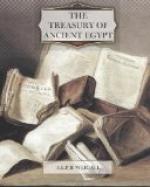In religious matters Horemheb at once adopted a strong attitude of friendship towards the Amon party which represented the old order of things. There is evidence to show that Aton was in no way persecuted; yet one by one his shrines were abandoned, and the neglected temples of Amon and the elder gods once more rang with the hymns of praise. Inscriptions tell us that the King “restored the temples from the marshes of the Delta to Nubia. He fashioned a hundred images with all their bodies correct, and with all splendid costly stones. He established for them daily offerings every day. All the vessels of their temples were wrought of silver and gold. He equipped them with priests and with ritual-priests, and with the choicest of the army. He transferred to them lands and cattle, supplied with all equipment.” By these gifts to the neglected gods, Horemheb was striving to bring Egypt back to its normal condition, and in no way was he prejudiced by any particular devotion to Amon.
A certain Patonemheb, who had been one of Akhnaton’s favourites in the days of the revolution, was appointed High Priest of Ra—the older Egyptian form of Aton who was at this time identified with that god—at the temple of Heliopolis; and this can only be regarded as an act of friendship to the Aton-worshippers. The echoing and deserted temples of Aton in Thebes, and El Amarna, however, were now pulled down, and the blocks were used for the enlarging of the temple of Amon,—a fact which indicates that their original dedication to Aton had not caused them to be accursed.
The process of restoration was so gradual that it could not have much disturbed the country. Horemheb’s hand was firm but soothing in these matters, and the revolution seems to have been killed as much by kindness as by force. It was probably not till quite the end of his reign that he showed any tendency to revile the memory of Akhnaton; and the high feeling which at length brought the revolutionary king the name of “that criminal of El Amarna” did not rise till half a century later. The difficulties experienced by Horemheb in steering his course between Amon and Aton, in quietly restoring the old equilibrium without in any way persecuting those who by religious convictions were Aton-worshippers, must have been immense; and one cannot but feel that the King must have been a diplomatist of the highest standing. His unaffected simplicity won all hearts to him; his toleration and broadness of mind brought all thoughtful men to his train; and his strong will led them and guided them from chaos to order, from fantastic Utopia to the solid old Egypt of the past. Horemheb was the preacher of Sanity, the apostle of the Normal, and Order was his watchword.




